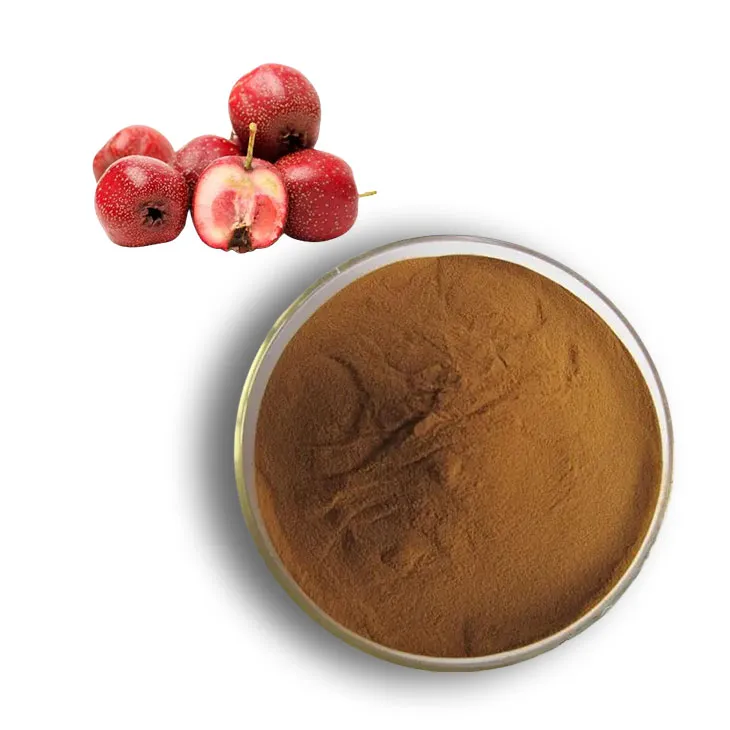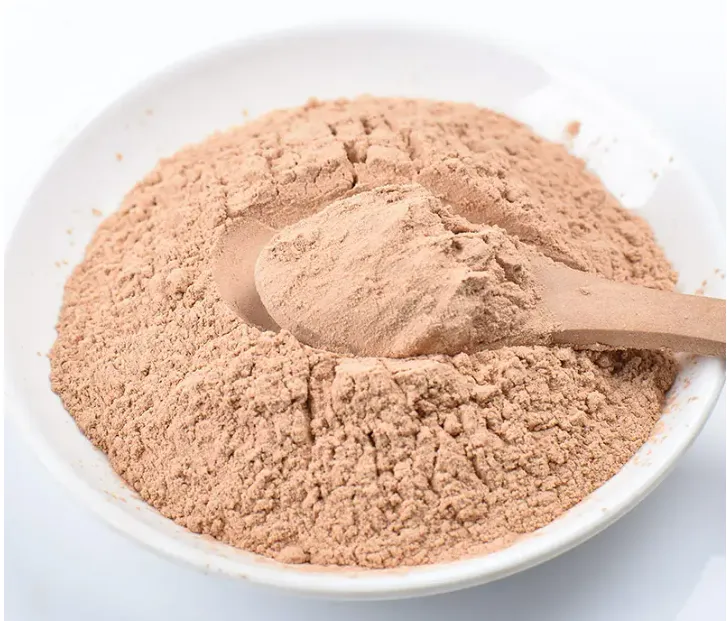- 0086-571-85302990
- sales@greenskybio.com
The process of extracting maslinic acid from hawthorn extract.
2024-11-26

1. Introduction to Hawthorn and Maslinic Acid
Hawthorn, a well - known plant in traditional medicine and food, has attracted considerable attention in the field of natural product research. It is rich in various bioactive compounds, among which maslinic acid is one of the important components. Maslinic acid is a triterpenoid compound with potential health - promoting properties. It has been reported to have antioxidant, anti - inflammatory, and anti - cancer activities, which makes it a valuable target for extraction and further study.

2. Obtaining Hawthorn Extract
2.1 Selection of Hawthorn Materials
The first step in extracting maslinic acid from hawthorn is to select suitable hawthorn materials. High - quality hawthorn fruits should be chosen, free from diseases, pests, and excessive contaminants. Different varieties of hawthorn may have different contents of maslinic acid, so it is also necessary to consider the variety factor. For example, some traditional local varieties may have a relatively high content of the target compound.2.2 Pretreatment of Hawthorn
Before extraction, the hawthorn needs to be pretreated. This usually includes cleaning to remove dirt, debris, and surface contaminants. Then, the hawthorn fruits may be dried, either naturally or by using drying equipment. Drying helps to preserve the hawthorn and make it easier for the subsequent extraction process. Additionally, the dried hawthorn may be ground into a powder to increase the surface area, which is beneficial for the extraction solvent to fully contact the active ingredients.2.3 Soxhlet Extraction
Soxhlet extraction is a commonly used method for obtaining Hawthorn Extract. In this process:- A suitable extraction solvent is selected. Organic solvents such as ethanol or methanol are often used due to their good solubility for many bioactive compounds in hawthorn. The solvent is placed in the Soxhlet extractor.
- The ground Hawthorn powder is loaded into a thimble and placed in the Soxhlet extractor. The extractor is then assembled and connected to a condenser.
- The solvent is heated, vaporizes, and rises to the condenser, where it condenses back into a liquid and drips onto the Hawthorn powder in the thimble. This continuous process allows the solvent to continuously extract the bioactive compounds from the hawthorn.
- After a certain period of extraction time (usually several hours to days, depending on the nature of the hawthorn and the required extraction efficiency), the extract containing a variety of bioactive compounds is obtained.

3. Separation of Maslinic Acid from Hawthorn Extract
3.1 Preliminary Purification
After obtaining the hawthorn extract, the next step is to carry out preliminary purification to remove some of the large - particle impurities and unwanted substances. This can be achieved through methods such as filtration and centrifugation.- Filtration: Using filter papers or filter membranes with appropriate pore sizes, the extract can be filtered to remove solid particles. This helps to obtain a relatively clear extract solution.
- Centrifugation: By spinning the extract at a high speed in a centrifuge, heavier particles can be separated from the liquid phase. The supernatant obtained after centrifugation contains a higher proportion of the desired bioactive compounds.
3.2 High - Performance Liquid Chromatography (HPLC)
HPLC is a crucial technique for the separation of maslinic acid from the hawthorn extract. Here is how it works:- Column Selection: A suitable HPLC column is selected based on the chemical properties of maslinic acid and the components in the hawthorn extract. For example, a reverse - phase C18 column is often used for the separation of triterpenoid compounds like maslinic acid.
- Mobile Phase Preparation: The mobile phase, which is a mixture of solvents, is prepared. The composition of the mobile phase can be adjusted to optimize the separation of maslinic acid from other compounds. Commonly used solvents in the mobile phase for maslinic acid separation include acetonitrile and water, and their ratios may be adjusted according to the specific separation requirements.
- Sample Injection: A small volume of the preliminarily purified hawthorn extract is injected into the HPLC system. The injector accurately controls the amount of sample introduced into the column.
- Separation Process: As the mobile phase flows through the column, different compounds in the extract interact differently with the stationary phase (the material inside the column) and the mobile phase. Due to the unique chemical structure of maslinic acid, it will be separated from other compounds and elute from the column at a specific time.
- Detection and Collection: A detector, such as a UV - Vis detector, is used to detect the eluted compounds. When maslinic acid is detected, the corresponding fraction can be collected for further purification or analysis.

4. Further Purification and Characterization
4.1 Further Purification
Although HPLC can effectively separate maslinic acid from the hawthorn extract, the collected fraction may still contain some minor impurities. To obtain high - purity maslinic acid, further purification methods can be employed. One such method is recrystallization.- Recrystallization involves dissolving the collected maslinic acid - containing fraction in a suitable solvent at an elevated temperature. Then, the solution is slowly cooled, allowing the maslinic acid to crystallize out while leaving the impurities in the solution. By repeating this process several times, a high - purity maslinic acid product can be obtained.
4.2 Characterization of Maslinic Acid
After obtaining high - purity maslinic acid, it is necessary to characterize it to confirm its chemical structure and purity.- Spectroscopic Analysis: Techniques such as infrared spectroscopy (IR), nuclear magnetic resonance (NMR), and mass spectrometry (MS) are commonly used. IR can provide information about the functional groups present in maslinic acid. NMR can give detailed information about the chemical environment of atoms in the molecule, and MS can determine the molecular weight and fragmentation pattern of maslinic acid.
- Purity Analysis: Chromatographic methods such as HPLC can be used again to determine the purity of the obtained maslinic acid. The area percentage of the maslinic acid peak in the chromatogram can be used as an indicator of its purity.
5. Applications of Maslinic Acid
5.1 Pharmaceutical Applications
The potential health - promoting properties of maslinic acid make it a promising candidate in the pharmaceutical industry.- As an antioxidant, maslinic acid can scavenge free radicals in the body, which may help prevent oxidative stress - related diseases such as cardiovascular diseases, neurodegenerative diseases, and cancer.
- Its anti - inflammatory properties can be used to develop drugs for treating inflammatory diseases like arthritis. By inhibiting the production of inflammatory mediators, maslinic acid may relieve inflammation symptoms.
5.2 Food Industry Applications
In the food industry, maslinic acid can also be used as a natural additive.- It can be added to functional foods as an antioxidant to extend the shelf life of food products. For example, in oils and fats, maslinic acid can prevent rancidity by inhibiting lipid oxidation.
- Maslinic acid may also have potential applications in the development of health - promoting food products. Due to its potential health benefits, it can be incorporated into foods such as dietary supplements, beverages, and health bars.
6. Conclusion
The extraction of maslinic acid from hawthorn extract is a complex but important process. Starting from the selection of high - quality hawthorn materials, through extraction, separation, further purification, and characterization, high - purity maslinic acid can be obtained. The obtained maslinic acid has great potential in both the pharmaceutical and food industries. With the continuous development of research techniques, it is expected that more efficient extraction methods and broader application prospects for maslinic acid will be explored in the future.
FAQ:
What is the first step in extracting maslinic acid from hawthorn extract?
The first step is to obtain a reliable hawthorn extract. This can be done through methods such as Soxhlet extraction.
Why is high - performance liquid chromatography (HPLC) important in the extraction of maslinic acid?
HPLC is important because it can accurately separate maslinic acid from other compounds based on its unique chemical properties.
What are the potential benefits of extracting maslinic acid from hawthorn?
Extracting maslinic acid from hawthorn is beneficial for exploring its potential health benefits. It also promotes the in - depth development and utilization of hawthorn resources in the pharmaceutical and food industries.
Are there other methods to separate maslinic acid from the hawthorn extract apart from HPLC?
While HPLC is a key modern separation technology, there may be other methods in research, but currently, HPLC is widely recognized for its accurate separation ability in this context. However, further research may discover alternative or complementary separation techniques.
How can we ensure the quality of the hawthorn extract obtained for maslinic acid extraction?
To ensure the quality of the hawthorn extract, proper extraction methods like Soxhlet extraction should be carried out carefully following standard procedures. This includes using high - quality hawthorn materials, controlling extraction parameters such as temperature, time, and solvent type, and ensuring the purity and stability of the extract during the process.
Related literature
- Isolation and Characterization of Maslinic Acid from Hawthorn: A Comprehensive Review"
- "The Role of Maslinic Acid in Health and the Extraction from Hawthorn"
- "Advances in the Extraction Technologies of Maslinic Acid from Hawthorn Extract"
- ▶ Hesperidin
- ▶ citrus bioflavonoids
- ▶ plant extract
- ▶ lycopene
- ▶ Diosmin
- ▶ Grape seed extract
- ▶ Sea buckthorn Juice Powder
- ▶ Beetroot powder
- ▶ Hops Extract
- ▶ Artichoke Extract
- ▶ Reishi mushroom extract
- ▶ Astaxanthin
- ▶ Green Tea Extract
- ▶ Curcumin Extract
- ▶ Horse Chestnut Extract
- ▶ Other Problems
- ▶ Boswellia Serrata Extract
- ▶ Resveratrol Extract
- ▶ Marigold Extract
- ▶ Grape Leaf Extract
- ▶ blog3
- ▶ blog4
-
Chinese Withania somnifera Extract Factory.
2024-11-26
-
中国松树皮提取物粉粉末供应商
2024-11-26
-
High - quality Marigold Extract Products.
2024-11-26
-
100% Pure Natural Mango - Flavored Powder.
2024-11-26
-
American Ginseng Root Extract
2024-11-26
-
Black Rice Extract
2024-11-26
-
Sophora Flavescens Root Extract
2024-11-26
-
Camu Camu Extract
2024-11-26
-
Green coffee bean Extract
2024-11-26
-
Hawthorn Extract
2024-11-26
-
Jujube Extract
2024-11-26
-
Chia Seed Powder
2024-11-26
-
Honeysuckle Pollen
2024-11-26
-
Artichoke Extract
2024-11-26




















